Genome Assessment of Carbapenem- and Colistin-Resistant Escherichia coli from Patients in a Sentinel Hospital in China
Abstract
1. Introduction
2. Materials and Methods
2.1. Bacteria Isolation and Identification
2.2. Antimicrobial Susceptibility Testing
2.3. Whole-Genome Sequencing and Annotation
2.4. S1-Pulsed-Field Gel Electrophoresis (PFGE) and Southern Blot
2.5. Conjugation Test
3. Results
3.1. Bacterial Strains
3.2. Antimicrobial Resistance Profile
3.3. Characterization of the blaNDM-1, blaNDM-5, and mcr-1 Genes
3.4. Genomic Characteristics Analysis
3.5. Plasmid Sequence and Comparative Analysis
4. Discussion
5. Conclusions
Author Contributions
Funding
Institutional Review Board Statement
Informed Consent Statement
Data Availability Statement
Conflicts of Interest
References
- Kumarasamy, K.K.; Toleman, M.A.; Walsh, T.R.; Bagaria, J.; Butt, F.; Balakrishnan, R.; Chaudhary, U.; Doumith, M.; Giske, C.G.; Irfan, S.; et al. Emergence of a new antibiotic resistance mechanism in India, Pakistan, and the UK: A molecular, biological, and epidemiological study. Lancet Infect. Dis. 2010, 10, 597–602. [Google Scholar] [CrossRef]
- Linciano, P.; Cendron, L.; Gianquinto, E.; Spyrakis, F.; Tondi, D. Ten years with New Delhi Metallo-β-lactamase-1 (NDM-1): From structural insights to inhibitor design. ACS Infect. Dis. 2019, 5, 9–34. [Google Scholar] [CrossRef] [PubMed]
- Zhang, Y.; Wang, Q.; Yin, Y.; Chen, H.; Jin, L.; Gu, B.; Xie, L.; Yang, C.; Ma, X.; Li, H.; et al. Epidemiology of carbapenem-resistant Enterobacteriaceae infections: Report from the China CRE Network. Antimicrob. Agents Chemother. 2018, 62, e01882-17. [Google Scholar] [CrossRef] [PubMed]
- Elbediwi, M.; Pan, H.; Zhou, X.; Rankin, S.C.; Schifferli, D.M.; Yue, M. Detection of mcr-9-harbouring ESBL-producing Salmonella Newport isolated from an outbreak in a large-animal teaching hospital in the USA. J. Antimicrob. Chemother. 2021, 76, 1107–1109. [Google Scholar] [CrossRef] [PubMed]
- Biswas, S.; Li, Y.; Elbediwi, M.; Yue, M. Emergence and dissemination of mcr-carrying clinically relevant Salmonella Typhimurium monophasic clone ST34. Microorganisms 2019, 7, 298. [Google Scholar] [CrossRef]
- Elbediwi, M.; Li, Y.; Paudyal, N.; Pan, H.; Li, X.; Xie, S.; Rajkovic, A.; Feng, Y.; Fang, W.; Rankin, S.C.; et al. Global burden of colistin-resistant bacteria: Mobilized colistin resistance genes study (1980–2018). Microorganisms 2019, 7, 461. [Google Scholar] [CrossRef]
- Elbediwi, M.; Beibei, W.; Pan, H.; Jiang, Z.; Biswas, S.; Li, Y.; Yue, M. Genomic characterization of mcr-1-carrying Salmonella enterica Serovar 4,[5],12:i:- ST 34 clone isolated from pigs in China. Front. Bioeng. Biotechnol. 2020, 8, 663. [Google Scholar] [CrossRef]
- He, T.; Wang, R.; Liu, D.; Walsh, T.R.; Zhang, R.; Lv, Y.; Ke, Y.; Ji, Q.; Wei, R.; Liu, Z.; et al. Emergence of plasmid-mediated high-level tigecycline resistance genes in animals and humans. Nat. Microbiol. 2019, 4, 1450–1456. [Google Scholar] [CrossRef]
- Hussein, N.H.; Al-Kadmy, I.M.S.; Taha, B.M.; Hussein, J.D. Mobilized colistin resistance (mcr) genes from 1 to 10: A comprehensive review. Mol. Biol. Rep. 2021, 48, 2897–2907. [Google Scholar] [CrossRef]
- Portes, A.B.; Rodrigues, G.; Leitão, M.P.; Ferrari, R.; Conte Junior, C.A.; Panzenhagen, P. Global distribution of plasmid-mediated colistin resistance mcr gene in Salmonella: A systematic review. J. Appl. Microbiol. 2022, 132, 872–889. [Google Scholar] [CrossRef]
- Park, J.; Yun, S.J.; Shin, E.; Kim, J.S.; Park, S.H.; Pyeon, H.S.; Kim, M.K.; Joo, S.; Jeong, H.J.; Chun, J.H.; et al. First identification of novel variants of New Delhi metallo-β-lactamase, NDM-30 and NDM-31, in the Republic of Korea. J. Glob. Antimicrob. Resist. 2022, 29, 20–22. [Google Scholar] [CrossRef]
- Umar, Z.; Chen, Q.; Tang, B.; Xu, Y.; Wang, J.; Zhang, H.; Ji, K.; Jia, X.; Feng, Y. The poultry pathogen Riemerella anatipestifer appears as a reservoir for Tet(X) tigecycline resistance. Environ. Microbiol. 2021, 23, 7465–7482. [Google Scholar] [CrossRef]
- Tang, B.; Yang, H.; Jia, X.; Feng, Y. Coexistence and characterization of Tet(X5) and NDM-3 in the MDR-Acinetobacter indicus of duck origin. Microb. Pathog. 2021, 150, 104697. [Google Scholar] [CrossRef] [PubMed]
- Poirel, L.; Madec, J.Y.; Lupo, A.; Schink, A.K.; Kieffer, N.; Nordmann, P.; Schwarz, S. Antimicrobial resistance in Escherichia coli. Microbiol. Spectr. 2018, 6, 4. [Google Scholar] [CrossRef] [PubMed]
- Wu, W.; Feng, Y.; Tang, G.; Qiao, F.; McNally, A.; Zong, Z. NDM Metallo-β-Lactamases and their bacterial producers in health care settings. Clin. Microbiol. Rev. 2019, 32, e00115-18. [Google Scholar] [CrossRef] [PubMed]
- Shen, Z.; Hu, Y.; Sun, Q.; Hu, F.; Zhou, H.; Shu, L.; Ma, T.; Shen, Y.; Wang, Y.; Li, J.; et al. Emerging carriage of NDM-5 and MCR-1 in Escherichia coli from healthy people in multiple regions in China: A cross sectional observational study. EClinicalMedicine 2018, 6, 11–20. [Google Scholar] [CrossRef] [PubMed]
- Tang, B.; Ma, Y.; He, X.; Zhou, Q.; Chang, J.; Qian, M.; Xia, X.; Yang, H. Similar antimicrobial resistance of Escherichia coli strains isolated from retail chickens and poultry farms. Foodborne Pathog. Dis. 2021, 18, 489–496. [Google Scholar] [CrossRef]
- Lin, J.; Tang, B.; Zheng, X.; Chang, J.; Ma, J.; He, Y.; Yang, H.; Wu, Y. Emergence of Incl2 plasmid-mediated colistin resistance in avian Escherichia fergusonii. FEMS Microbiol. Lett. 2022, 369, fnac016. [Google Scholar] [CrossRef] [PubMed]
- Tang, B.; Chang, J.; Cao, L.; Luo, Q.; Xu, H.; Lyu, W.; Qian, M.; Ji, X.; Zhang, Q.; Xia, X.; et al. Characterization of an NDM-5 carbapenemase-producing Escherichia coli ST156 isolate from a poultry farm in Zhejiang, China. BMC Microbiol. 2019, 19, 82. [Google Scholar] [CrossRef]
- Wayne, P. Performance Standards for Antimicrobial Susceptibility Testing; Clinical and Laboratory Standards Institute: Wayne, PA, USA, 2019; M100-S129; pp. 30–37. [Google Scholar]
- Brettin, T.; Davis, J.J.; Disz, T.; Edwards, R.A.; Gerdes, S.; Olsen, G.J.; Olson, R.; Overbeek, R.; Parrello, B.; Pusch, G.D.; et al. RASTtk: A modular and extensible implementation of the RAST algorithm for building custom annotation pipelines and annotating batches of genomes. Sci. Rep. 2015, 5, 8365. [Google Scholar] [CrossRef] [PubMed]
- Li, Y.; Ed-Dra, A.; Tang, B.; Kang, X.; Müller, A.; Kehrenberg, C.; Jia, C.; Pan, H.; Yang, H.; Yue, M. Higher tolerance of predominant Salmonella serovars circulating in the antibiotic-free feed farms to environmental stresses. J. Hazard. Mater. 2022, 438, 129476. [Google Scholar] [CrossRef] [PubMed]
- Li, Y.; Kang, X.; Ed-Dra, A.; Zhou, X.; Jia, C.; Müller, A.; Liu, Y.; Kehrenberg, C.; Yue, M. Genome-based assessment of antimicrobial resistance and virulence potential of isolates of non-pullorum/gallinarum Salmonella Serovars recovered from dead poultry in China. Microbiol. Spectr. 2022, 10, e0096522. [Google Scholar] [CrossRef] [PubMed]
- Wu, B.; Ed-Dra, A.; Pan, H.; Dong, C.; Jia, C.; Yue, M. Genomic Investigation of Salmonella isolates recovered from a pig slaughtering process in Hangzhou, China. Front. Microbiol. 2021, 12, 704636. [Google Scholar] [CrossRef]
- Qiu, Y.F.; Nambiar, R.B.; Xu, X.B.; Weng, S.T.; Pan, H.; Zheng, K.C.; Yue, M. Global genomic characterization of Salmonella enterica Serovar Telelkebir. Front. Microbiol. 2021, 12, 704152. [Google Scholar] [CrossRef] [PubMed]
- Tang, B.; Chang, J.; Zhang, L.; Liu, L.; Xia, X.; Hassan, B.H.; Jia, X.; Yang, H.; Feng, Y. Carriage of distinct mcr-1-harboring plasmids by unusual serotypes of Salmonella. Adv. Biosyst. 2020, 4, e1900219. [Google Scholar] [CrossRef] [PubMed]
- Siguier, P.; Perochon, J.; Lestrade, L.; Mahillon, J.; Chandler, M. ISfinder: The reference centre for bacterial insertion sequences. Nucleic Acids Res. 2006, 34, D32–D36. [Google Scholar] [CrossRef] [PubMed]
- Ma, J.; Wang, J.; Feng, J.; Liu, Y.; Yang, B.; Li, R.; Bai, L.; He, T.; Wang, X.; Yang, Z. Characterization of three porcine Acinetobacter towneri strains co-harboring tet(X3) and bla(OXA-58). Front. Cell. Infect. Microbiol. 2020, 10, 586507. [Google Scholar] [CrossRef]
- Tang, B.; Chang, J.; Chen, Y.; Lin, J.; Xiao, X.; Xia, X.; Lin, J.; Yang, H.; Zhao, G. Escherichia fergusonii, an underrated repository for antimicrobial resistance in food animals. Microbiol. Spectr. 2022, 10, e0161721. [Google Scholar] [CrossRef]
- Lei, L.; Rehman, M.U.; Huang, S.; Zhang, L.; Wang, L.; Mehmood, K.; Zhang, H.; Tong, X.; Wang, M.; Li, J. Antimicrobial resistance and prevalence of diarrheagenic Escherichia coli (DEC), in diarrheic yaks of Tibetan Plateau, China. Acta Trop. 2018, 182, 111–114. [Google Scholar] [CrossRef]
- Tobias, J.; Vutukuru, S.R. Simple and rapid multiplex PCR for identification of the main human diarrheagenic Escherichia coli. Microbiol. Res. 2012, 167, 564–570. [Google Scholar] [CrossRef]
- Ito, Y.; Aoki, K.; Ishii, Y.; Nakayama, H.; Otsuka, M.; Kaneko, N.; Yoshida, M.; Tateda, K.; Matsuse, H. Whole-genome sequencing analysis of bla(NDM-5)/IncX3 plasmid estimated to be conjugative-transferred in the gut. Microb. Drug Resist. 2022, 28, 539–544. [Google Scholar] [CrossRef] [PubMed]
- Li, Y.; Tang, M.; Dai, X.; Zhou, Y.; Zhang, Z.; Qiu, Y.; Li, C.; Zhang, L. Whole-genomic analysis of NDM-5-producing Enterobacteriaceae recovered from an urban river in China. Infect. Drug Resist. 2021, 14, 4427–4440. [Google Scholar] [CrossRef] [PubMed]
- Liu, B.T.; Song, F.J. Emergence of two Escherichia coli strains co-harboring mcr-1 and bla(NDM) in fresh vegetables from China. Infect. Drug Resist. 2019, 12, 2627–2635. [Google Scholar] [CrossRef] [PubMed]
- Lv, D.; Duan, R.; Fan, R.; Mu, H.; Liang, J.; Xiao, M.; He, Z.; Qin, S.; Yang, J.; Jing, H.; et al. bla(NDM) and mcr-1 to mcr-5 gene distribution characteristics in gut specimens from different regions of China. Antibiotics 2021, 10, 233. [Google Scholar] [CrossRef]
- Dong, N.; Zeng, Y.; Cai, C.; Sun, C.; Lu, J.; Liu, C.; Zhou, H.; Sun, Q.; Shu, L.; Wang, H.; et al. Prevalence, transmission, and molecular epidemiology of tet(X)-positive bacteria among humans, animals, and environmental niches in China: An epidemiological, and genomic-based study. Sci. Total Environ. 2022, 818, 151767. [Google Scholar] [CrossRef]
- Feng, J.; Su, M.; Li, K.; Ma, J.; Li, R.; Bai, L.; Wang, X.; Wang, J.; Yang, Z. Extensive spread of tet(X4) in multidrug-resistant Escherichia coli of animal origin in western China. Vet. Microbiol. 2022, 269, 109420. [Google Scholar] [CrossRef]
- Fan, R.; Li, C.; Duan, R.; Qin, S.; Liang, J.; Xiao, M.; Lv, D.; Jing, H.; Wang, X. Retrospective screening and analysis of mcr-1 and bla(NDM) in gram-negative bacteria in China, 2010–2019. Front. Microbiol. 2020, 11, 121. [Google Scholar] [CrossRef]
- Anyanwu, M.U.; Jaja, I.F.; Nwobi, O.C. Occurrence and characteristics of mobile colistin resistance (mcr) gene-containing isolates from the environment: A review. Int. J. Environ. Res. Public Health 2020, 17, 1028. [Google Scholar] [CrossRef]
- Tartor, Y.H.; Gharieb, R.M.A.; Abd El-Aziz, N.K.; El Damaty, H.M.; Enany, S.; Khalifa, E.; Attia, A.S.A.; Abdellatif, S.S.; Ramadan, H. Virulence determinants and plasmid-mediated colistin resistance mcr genes in gram-negative bacteria isolated from bovine milk. Front. Cell. Infect. Microbiol. 2021, 11, 761417. [Google Scholar] [CrossRef]
- Pérez-Vázquez, M.; Sola Campoy, P.J.; Ortega, A.; Bautista, V.; Monzón, S.; Ruiz-Carrascoso, G.; Mingorance, J.; González-Barberá, E.M.; Gimeno, C.; Aracil, B.; et al. Emergence of NDM-producing Klebsiella pneumoniae and Escherichia coli in Spain: Phylogeny, resistome, virulence and plasmids encoding blaNDM-like genes as determined by WGS. J. Antimicrob. Chemother. 2019, 74, 3489–3496. [Google Scholar] [CrossRef]
- Hu, Y.Y.; Wang, Y.L.; Sun, Q.L.; Huang, Z.X.; Wang, H.Y.; Zhang, R.; Chen, G.X. Colistin resistance gene mcr-1 in gut flora of children. Int. J. Antimicrob. Agents 2017, 50, 593–597. [Google Scholar] [CrossRef] [PubMed]
- Ćwiek, K.; Woźniak-Biel, A.; Karwańska, M.; Siedlecka, M.; Lammens, C.; Rebelo, A.R.; Hendriksen, R.S.; Kuczkowski, M.; Chmielewska-Władyka, M.; Wieliczko, A. Phenotypic and genotypic characterization of mcr-1-positive multidrug-resistant Escherichia coli ST93, ST117, ST156, ST10, and ST744 isolated from poultry in Poland. Braz. J. Microbiol. 2021, 52, 1597–1609. [Google Scholar] [CrossRef] [PubMed]
- Kim, Y.J.; Moon, J.S.; Oh, D.H.; Chon, J.W.; Song, B.R.; Lim, J.S.; Heo, E.J.; Park, H.J.; Wee, S.H.; Sung, K. Genotypic characterization of ESBL-producing E. coli from imported meat in South Korea. Food Res. Int. 2018, 107, 158–164. [Google Scholar] [CrossRef] [PubMed]
- Vingino, A.; Roberts, M.C.; Wainstein, M.; West, J.; Norman, S.A.; Lambourn, D.; Lahti, J.; Ruiz, R.; D’Angeli, M.; Weissman, S.J.; et al. Surveillance for antibiotic-resistant E. coli in the Salish Sea Ecosystem. Antibiotics 2021, 10, 1201. [Google Scholar] [CrossRef]
- Xia, F.; Jiang, M.; Wen, Z.; Wang, Z.; Wang, M.; Xu, Y.; Zhuge, X.; Dai, J. Complete genomic analysis of ST117 lineage extraintestinal pathogenic Escherichia coli (ExPEC) to reveal multiple genetic determinants to drive its global transmission: ST117 E. coli as an emerging multidrug-resistant foodborne ExPEC with zoonotic potential. Transbound. Emerg. Dis. 2022. [Google Scholar] [CrossRef]
- Hornsey, M.; Phee, L.; Wareham, D.W. A novel variant, NDM-5, of the New Delhi metallo-β-lactamase in a multidrug-resistant Escherichia coli ST648 isolate recovered from a patient in the United Kingdom. Antimicrob. Agents Chemother. 2011, 55, 5952–5954. [Google Scholar] [CrossRef]
- Li, F.; Ye, K.; Li, X.; Ye, L.; Guo, L.; Wang, L.; Yang, J. Genetic characterization of carbapenem-resistant Escherichia coli from China, 2015–2017. BMC Microbiol. 2021, 21, 248. [Google Scholar] [CrossRef]
- Tang, B.; Ni, J.; Lin, J.; Sun, Y.; Lin, H.; Wu, Y.; Yang, H.; Yue, M. Genomic characterization of multidrug-resistance gene cfr in Escherichia coli recovered from food animals in Eastern China. Front. Microbiol. 2022, 13, 999778. [Google Scholar] [CrossRef]
- Zhao, Q.Y.; Zhu, J.H.; Cai, R.M.; Zheng, X.R.; Zhang, L.J.; Chang, M.X.; Lu, Y.W.; Fang, L.X.; Sun, J.; Jiang, H.X. IS26 is responsible for the evolution and transmission of bla(NDM)-harboring plasmids in Escherichia coli of poultry origin in China. mSystems 2021, 6, e0064621. [Google Scholar] [CrossRef]
- Farzana, R.; Jones, L.S.; Barratt, A.; Rahman, M.A.; Sands, K.; Portal, E.; Boostrom, I.; Espina, L.; Pervin, M.; Uddin, A.; et al. Emergence of mobile colistin resistance (mcr-8) in a highly successful Klebsiella pneumoniae sequence type 15 clone from clinical infections in Bangladesh. mSphere 2020, 5, e00023-20. [Google Scholar] [CrossRef]
- Foley, S.L.; Kaldhone, P.R.; Ricke, S.C.; Han, J. Incompatibility group I1 (IncI1) plasmids: Their genetics, biology, and public health relevance. Microbiol. Mol. Biol. Rev. 2021, 85, e00031-20. [Google Scholar] [CrossRef] [PubMed]
- Stosic, M.S.; Sunde, M.; Mo, S.S.; Telke, A.A.; Rudi, K. Interference of ISEcp1-bla(CTX-M-1) with the shufflon rearrangement in IncI1 plasmids. Plasmid 2021, 116, 102578. [Google Scholar] [CrossRef] [PubMed]
- Brouwer, M.S.M.; Jurburg, S.D.; Harders, F.; Kant, A.; Mevius, D.J.; Roberts, A.P.; Bossers, A. The shufflon of IncI1 plasmids is rearranged constantly during different growth conditions. Plasmid 2019, 102, 51–55. [Google Scholar] [CrossRef] [PubMed]
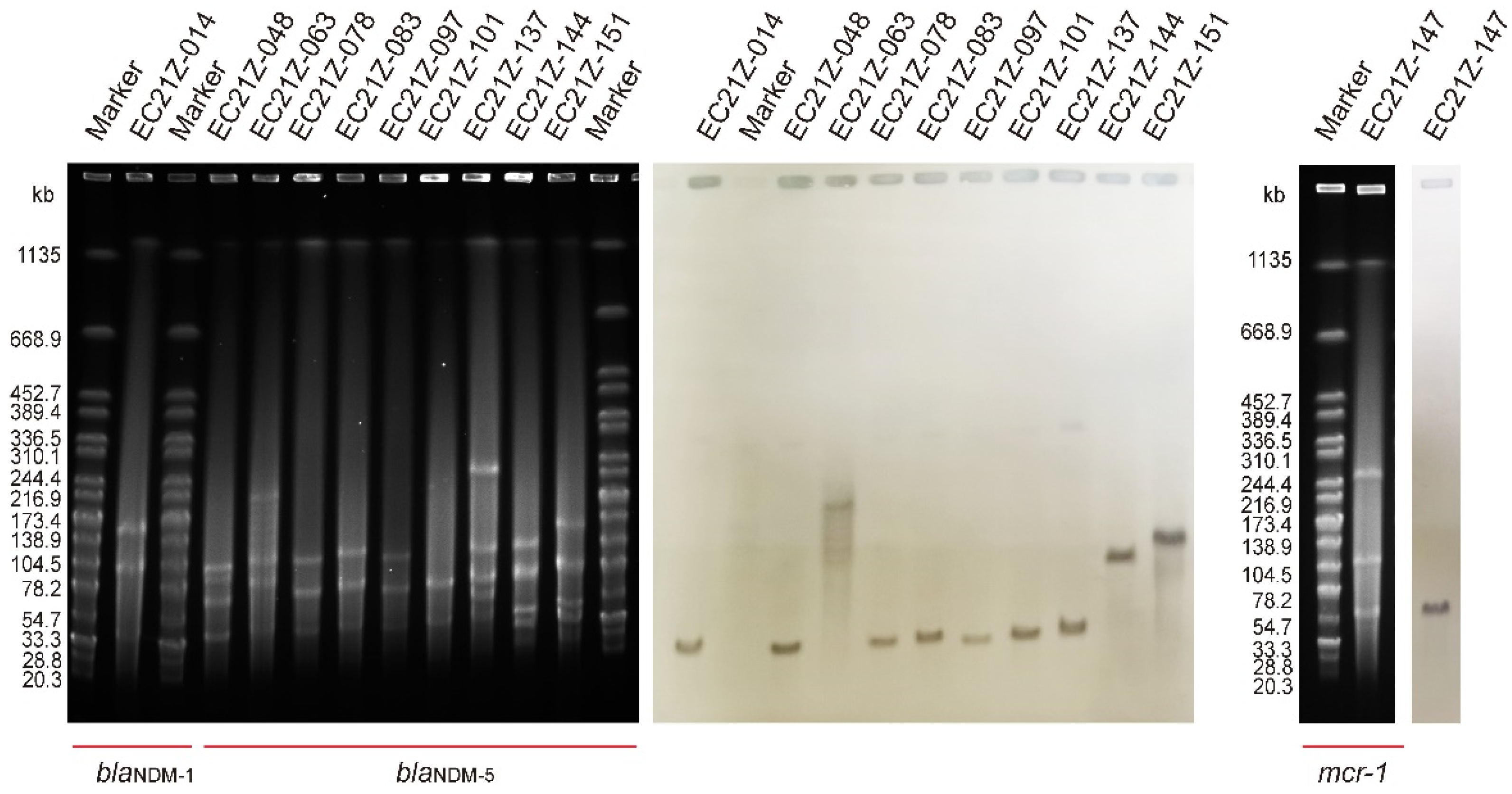

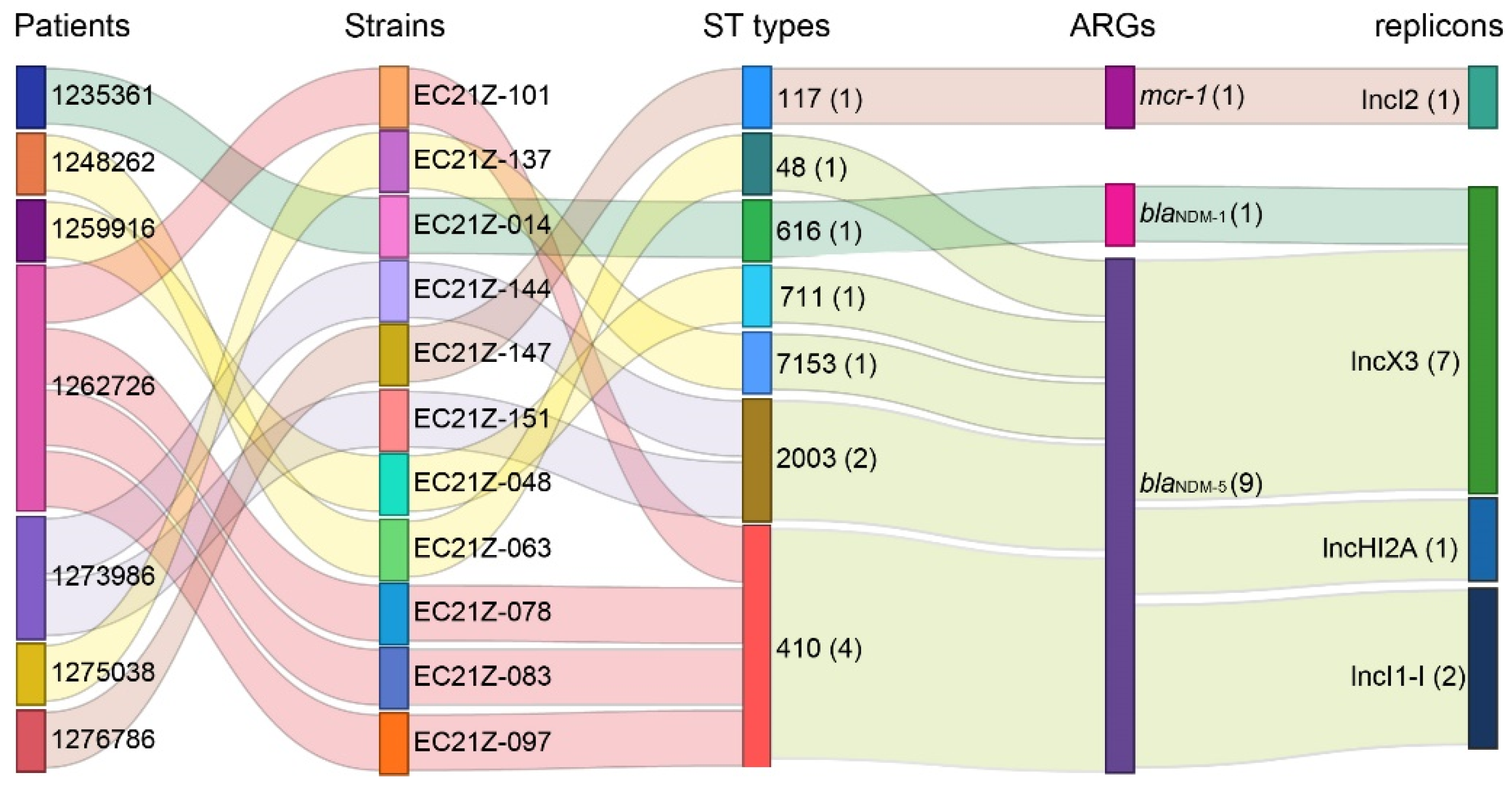
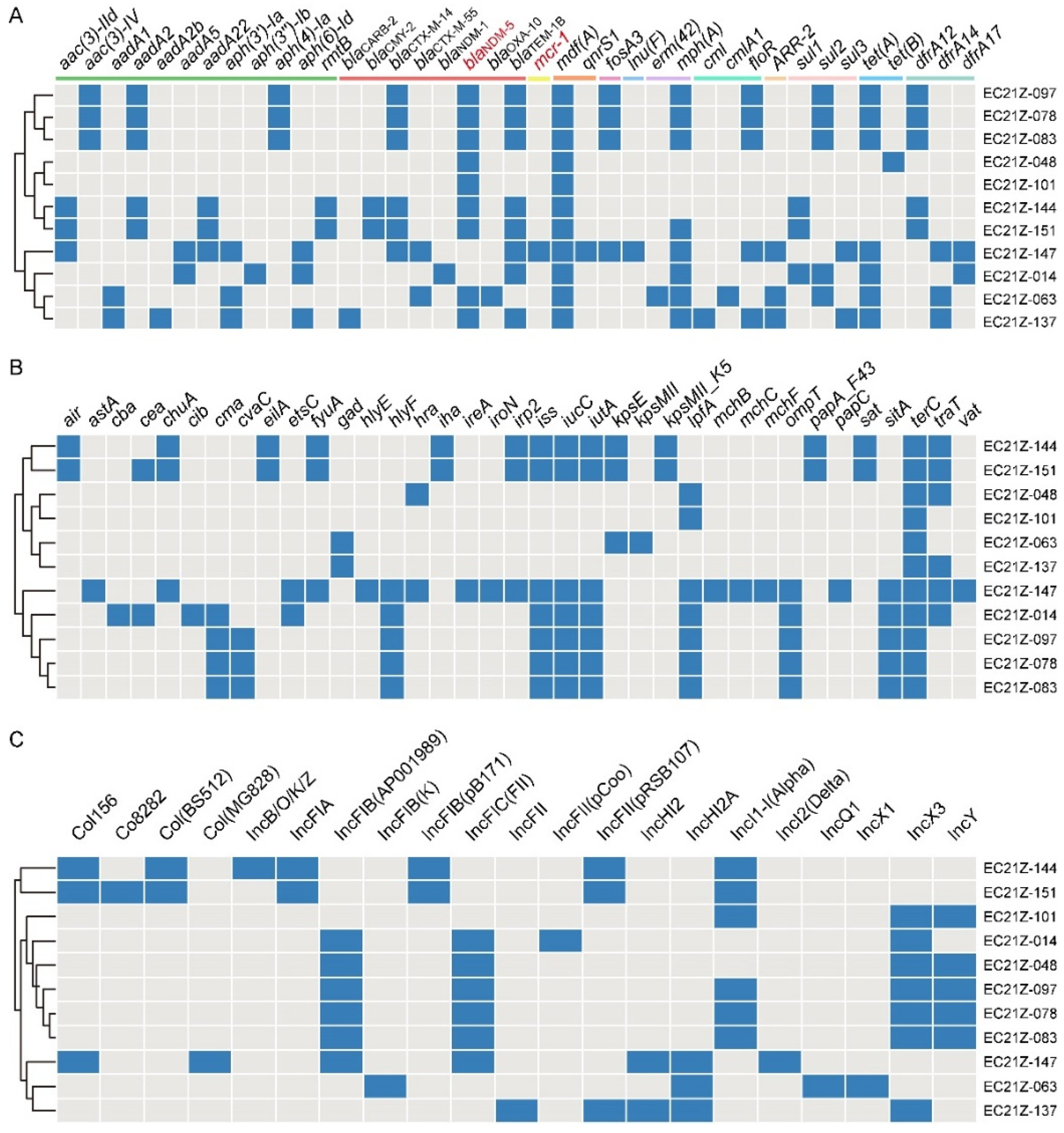
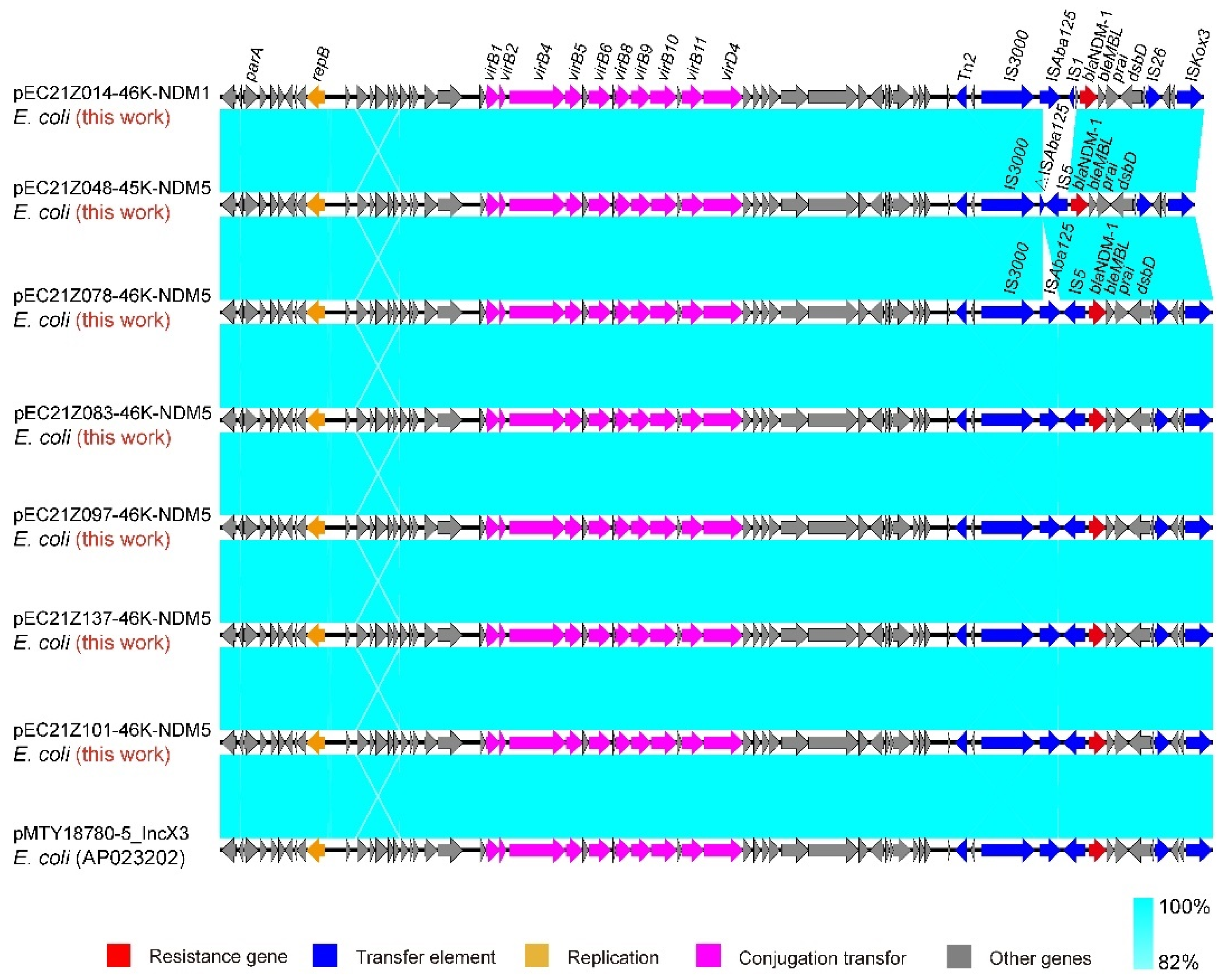
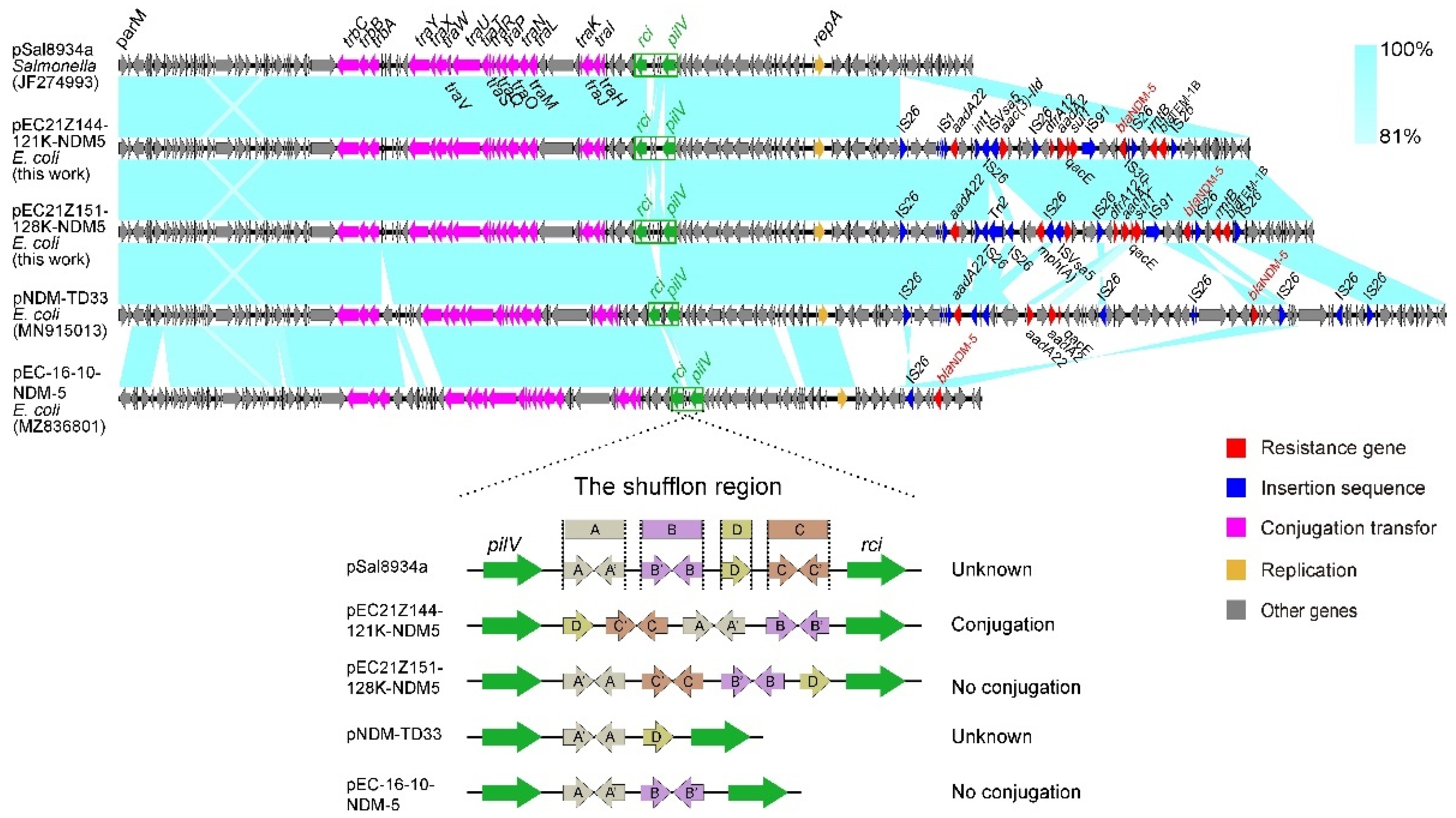
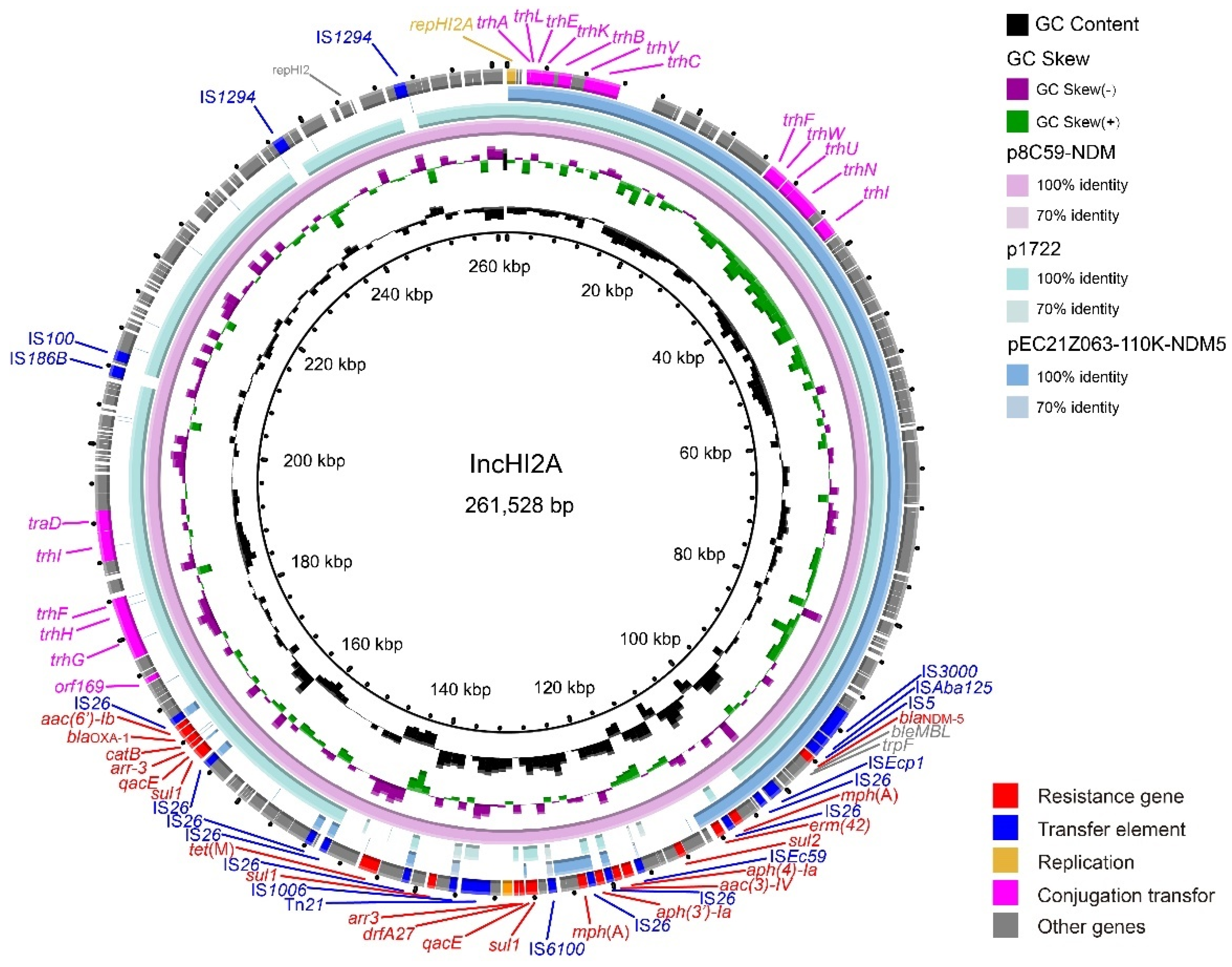

| Patient | Sex | Age | Clinical Diagnosis | Department | Isolate | Isolation Source | Collection Date | AMR Phenotype |
|---|---|---|---|---|---|---|---|---|
| 01235361 | male | 65 years | choledocholithiasis | inpatient | EC21Z-014 | lung | 2021/1/25 | meropenem |
| 01259916 | male | 73 years | cholangiolithiasis with cholangitis | inpatient | EC21Z-048 | stool | 2021/2/13 | meropenem |
| 01248262 | female | 58 years | multiple myeloma | inpatient | EC21Z-063 | stool | 2021/3/5 | meropenem |
| 01262726 | female | 61 years | diffuse large B-cell lymphoma | inpatient | EC21Z-078 | stool | 2021/3/29 | meropenem |
| EC21Z-083 | lung | 2021/3/29 | meropenem | |||||
| EC21Z-097 | stool | 2021/4/6 | meropenem | |||||
| EC21Z-101 | lung | 2021/4/13 | meropenem | |||||
| 01275038 | male | 52 years | obstructive jaundice | inpatient | EC21Z-137 | stool | 2021/5/31 | meropenem |
| 01273986 | female | 49 years | non-hodgkin lymphoma | inpatient | EC21Z-144 | stool | 2021/6/8 | meropenem |
| EC21Z-151 | stool | 2021/6/15 | meropenem | |||||
| 01276786 | female | 1 day | health | inpatient | EC21Z-147 | lung | 2021/6/8 | colistin |
| Strains | AMP | A/C | GEM | SPT | TET | FFC | SF | SXT | CEF | CAZ | ENR | OFL | MEM | COL | Antimicrobial Resistance Patterns |
|---|---|---|---|---|---|---|---|---|---|---|---|---|---|---|---|
| EC21Z-014 | R | R | S | R | R | I | R | R | R | R | I | S | R | S | AMP-A/C-SPT-TET-SF-SXT-CEF-CAZ-MEM |
| EC21Z-048 | R | R | S | S | R | I | R | S | R | R | S | S | R | S | AMP-A/C-TET-SF-CEF-CAZ-MEM |
| EC21Z-063 | R | R | S | R | R | R | R | R | R | R | I | S | R | S | AMP-A/C-SPT-TET-FFC-SF-SXT-CEF-CAZ-MEM |
| EC21Z-078 | R | R | I | R | R | R | R | R | R | R | R | R | R | S | AMP-A/C-SPT-TET-FFC-SF-SXT-CEF-CAZ-ENR-OFL-MEM |
| EC21Z-083 | R | R | I | R | R | R | R | R | R | R | R | R | R | S | AMP-A/C-SPT-TET-FFC-SF-SXT-CEF-CAZ-ENR-OFL-MEM |
| EC21Z-097 | R | R | I | R | R | R | R | R | R | R | R | R | R | S | AMP-A/C-SPT-TET-FFC-SF-SXT-CEF-CAZ-ENR-OFL-MEM |
| EC21Z-101 | R | R | S | S | I | R | R | S | R | R | R | R | R | S | AMP-A/C-FFC-SF--CEF-CAZ-ENR-OFL-MEM |
| EC21Z-137 | R | R | S | R | R | R | R | R | R | R | R | R | R | S | AMP-A/C-SPT-TET-FFC-SF-SXT-CEF-CAZ-ENR-OFL-MEM |
| EC21Z-144 | R | R | R | R | S | R | R | R | R | R | R | R | R | S | AMP-A/C-GEM-SPT-FFC-SF-SXT-CEF-CAZ-ENR-OFL-MEM |
| EC21Z-151 | R | R | R | R | S | R | R | R | R | R | R | R | R | S | AMP-A/C-GEM-SPT-FFC-SF-SXT-CEF-CAZ-ENR-OFL-MEM |
| EC21Z-147 | R | S | R | R | R | R | R | R | R | I | R | R | S | R | AMP-GEM-SPT-TET-FFC-SF-SXT-CEF-ENR-OFL-COL |
| Rate (%) | 100 | 90.9 | 27.2 | 81.8 | 72.7 | 81.8 | 100 | 81.8 | 100 | 90.9 | 72.7 | 72.7 | 90.9 | 9.1 | - |
Publisher’s Note: MDPI stays neutral with regard to jurisdictional claims in published maps and institutional affiliations. |
© 2022 by the authors. Licensee MDPI, Basel, Switzerland. This article is an open access article distributed under the terms and conditions of the Creative Commons Attribution (CC BY) license (https://creativecommons.org/licenses/by/4.0/).
Share and Cite
Ma, J.; Tang, B.; Lin, J.; Ed-Dra, A.; Lin, H.; Wu, J.; Dong, Y.; Yang, H.; Yue, M. Genome Assessment of Carbapenem- and Colistin-Resistant Escherichia coli from Patients in a Sentinel Hospital in China. Cells 2022, 11, 3480. https://doi.org/10.3390/cells11213480
Ma J, Tang B, Lin J, Ed-Dra A, Lin H, Wu J, Dong Y, Yang H, Yue M. Genome Assessment of Carbapenem- and Colistin-Resistant Escherichia coli from Patients in a Sentinel Hospital in China. Cells. 2022; 11(21):3480. https://doi.org/10.3390/cells11213480
Chicago/Turabian StyleMa, Jiangang, Biao Tang, Jiahui Lin, Abdelaziz Ed-Dra, Hui Lin, Jing Wu, Yuzhi Dong, Hua Yang, and Min Yue. 2022. "Genome Assessment of Carbapenem- and Colistin-Resistant Escherichia coli from Patients in a Sentinel Hospital in China" Cells 11, no. 21: 3480. https://doi.org/10.3390/cells11213480
APA StyleMa, J., Tang, B., Lin, J., Ed-Dra, A., Lin, H., Wu, J., Dong, Y., Yang, H., & Yue, M. (2022). Genome Assessment of Carbapenem- and Colistin-Resistant Escherichia coli from Patients in a Sentinel Hospital in China. Cells, 11(21), 3480. https://doi.org/10.3390/cells11213480










